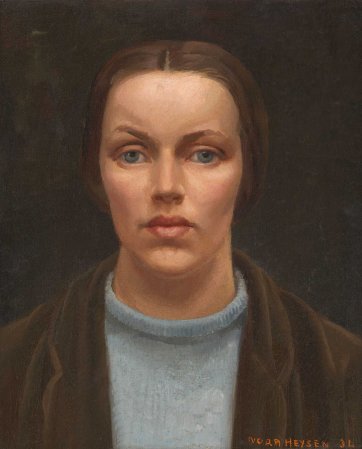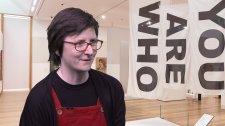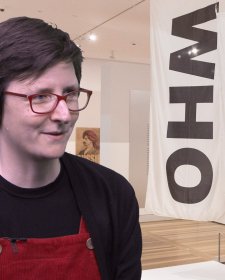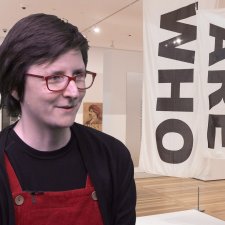I've picked two self portraits, both by women artists and made roughly a hundred or more years apart.
- I guess my, sort of, favourites, I've gone for a couple of self portraits that, once again, sort of, represent a good, kind of, time span. So, I've picked two self portraits, both by women artists and made roughly a hundred or more years apart. A really gorgeous little, and I mean little like 10 centimetre high.
- Oh, that is little.
- Yeah.
- Little, I was like, "Oh yes, maybe."
- Yeah. No, tiny. She, well, Georgiana McCrae is the artist.
- [Kate] Right.
- [Jo] It's a, it's a work from the NGV's collection. They acquired it in 2009 from her great-great-grandson-
- [Kate] Oh wow.
- [Jo] I think.
- [Kate] There you go.
- And she was trained as a miniature painter, so hence the, the miniature sizes, you know. That's no surprise. And the other one is a portrait from the 1930s painted by Nora Heysen. And, which is easily one of my favourite works in our own collection, and both for very, sort of, different reasons I think. With Nora, it's a... Our former director Andrew used to say, "It's a small portrait," and it is small. It's like you're, sort of, looking at her and the exact size of her face when you look at Nora's portrait.
- [Kate] It's, sort of, one to one.
- So, Andrew used to say that it's a small picture, but it's monumental. And I think what he was referring to there was the place of Nora's 1934 self portrait in the context of the self portraits that she'd made earlier.
- Oh.
- And they're very interesting. So, she made... I mean, she was an incredibly talented woman as we know. Not only was she, she was the daughter Sir Hans Heysen, the really distinguished landscape painter, but she was an incredible artist in her own right. And one of the reasons she said, in a oral history that she recorded once, was that she started painting portraits and painting people and painting herself because she wanted to get away from her father's subject matter and to be seen as an artist in her own right and not just the daughter of-
- The daughter of Hans Heysen.
- [Jo] Sir Hans Heysen, yeah.
- Daughter of, wife of. That can happen sometimes.
- [Jo] Yeah.
- Yeah. Oh, cool, interesting.
- And she made, she made a lot of self portraits, sort of, when she was in her, I guess, her early twenties.
- [Kate] Yeah.
- You know, so early 1930s, and there's a number of them. They're wonderful, but they're very much Nora projecting herself as an artist. So, you see her, sort of, seated, not quite full length but standing or seated with an easel or a pallet or a brush or she's wearing a smock. So, they're very much this, sort of, outward projection. This is who I am , which is why when you see those images and then you see Nora's picture from 1934-
- It's very different.
- It's a totally different, sort of, experience. You're looking her straight in the eye, and you get a sense from seeing it that she's really interrogating herself too, really, kind of, scrutinising herself, not putting on a performance as she was in the self portraits that are slightly earlier than this one, but actually really, sort of, confronting the reality of her situation for the first time. So, it's this incredibly intense and actually quite moving portrait, I think too, and to really, sort of, see her and be able to look her in the eye and try and, kind of, reflect on or imagine what she must have been thinking and feeling at the time that she painted it. It's, yeah, it's a really powerful little painting. And interestingly, I think too, it's a work that Nora kept her entire life. You know, a lot of the other self portraits that she made when she was in her early twenties were, you know, snapped up round about the time that they were made or not much later. So, the fact that she-
- That's interesting
- hung onto this one makes me think, well, maybe there was something really significant about it for her.
- Well, yeah, about that public image of what she wanted to show or not show.
- That's right.
- Because it is very intimate portrait in that way because what she was thinking.
- Yeah.
- To keep it.
- Yeah.
- That's fascinating.
- And then Georgiana McCrae-
- Right.
- The other self portrait that I've chosen, hundred years earlier almost-
- Back in time.
- than Nora's self-portrait, made around about 1829 or 1830, which is a real, kind of, 1830 is a, sort of, a landmark date I think, in terms of Georgiana McCrae's work. She's an incredible woman. She was born in 1804, died in 1890. She was the illegitimate daughter of the Duke of Gordon, who acknowledged her. He didn't, you know, try to pretend that she wasn't his daughter. So she was, even though she was illegitimate, she still was, she had access to the sort of education that other women of that class would've had. So, she was incredibly talented as a musician. She spoke French fluently, you know, and of course, she could, she had lessons in art as well because that was a thing that young ladies did, of a certain class, because that was an accomplishment that would help you get a husband. But she was prodigiously talented
- [Kate] Wow.
- As an artist. She was 16, for example, when she had some examples of her miniatures exhibited at the Royal Academy.
- Oh wow.
- She kept a list in her journal of the number of portraits that she'd painted, miniature portraits-
- [Kate] Oh, wow.
- that she'd painted. And she quite, you know, brazenly and openly says, "I painted these for fame and money," which of course, for a woman to earn a living, it was really frowned upon.
- Yeah.
- It's fine to do some drawing and make some portraits of your friends or yourself or your pets to be, you know, an elegant, sort of, educated lady. But to actually make money from it was something that was-
- Wow.
- was frowned upon. So, when she got married in September, 1830, she wrote in her journal because she kept these amazing diaries for most of her life. She wrote, "I left my easel and changed my name," and she had £225 in the bank at that time from painting portraits.
- [Kate] Oh, Wow.
- So, by not being able to paint portraits potentially now that she was married, that was, you know, that was a major, sort of-
- [Kate] Yeah.
- sort of, loss of her, not just loss of income-
- [Kate] What she was.
- but loss of her, sort of, identity-
- [Kate] Yeah, what she was .
- And sense of pride and so forth. So, she was a very wishy, very vivacious, incredibly clever woman. And what I love about this particular work is that all of that passion, that talent that, you know, that incredible intelligence, I think comes through but on this, you know, tiny little scale. It's such a wonderful... It's just such a wonderful object. Yeah. And I can't, you know... If there was one thing in the entire show that I could keep for our collection and that would find a home here as equally as it does in the NGV's collection, well then, I think it'd be Georgiana McCrae's self portrait.


















